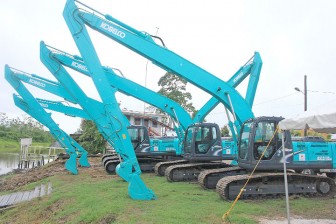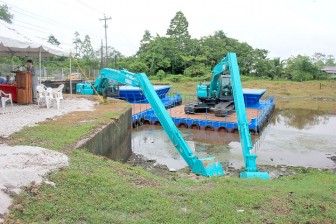Japan yesterday presented eight long-arm excavators and two pontoons to Guyana as part of a continuing project to rehabilitate the critical East Demerara Water Conservancy (EDWC).
The handing over was done between the Japan International Cooperation Agency (JICA) and Guyana’s National Drainage and Irrigation Authority (NDIA) and saw Agriculture Minister Dr Leslie Ramsammy warning that unless drainage and irrigation is adequately taken care of, Guyana could lose its middle-income status.

The EDWC’s primary function is as a source of irrigation for agricultural lands during the dry season but in the last decade it has become pivotal in the fight against flooding. Overtopping of the EDWC was one of the prime causes of the 2005 Great Flood.
This part of the project, which was agreed upon and signed in September 2011, was funded under the Grant Aid Scheme of the Govern-ment of Japan to the tune of US$3,480,000.
Emphasizing the importance of agriculture to the Guyanese way of life, Ramsammy stated that 33% of Guyanese are involved in agricultural activities and that 21% of Guyana’s economy is composed of agriculture.
Prime Minister Samuel Hinds added that the equipment received will enable the country to improve flood control and contribute to overall better management of the conservancy. He added that if government is unable to properly manage the conservancy, 300,000 Guyanese as well as 17,000 hectares of prime agriculture land would be adversely affected. He also stated that a whopping 85% of economic activities, by virtue of being located on the coastline, would be threatened.
In 2005, heavy rainfall and insufficient drainage resulted in the worst flooding the country had ever experienced. Prime Minister Hinds said that according to a United Nations Development Project Report 40% of the Guyanese population were severely affected by the flooding and that during that period, the economy lost approximately $92.2billion in revenue. “This must never happen again”, said the Prime Minister.
He also said that in the wake of this disaster, Japan was one of the first countries to assist, providing approximately US$120,000 in initial flood relief funds.
Yoshimasa Tezuka, the Japanese Ambassador to Guyana, acknowledged the 2005 disaster and made reference to the tsunami and earthquake which devastated his own country on March 11th last year. He mentioned that “Japan and Guyana have in common the effects of climate change,” and that since it is impossible to prevent the occurrence of natural disasters, it is imperative that countries take all measures necessary to mitigate the damage sustained when they do occur.

He stated that it was the realization of this fact that convinced his government to move ahead with the agreement despite massive loss of life, revenue and infrastructure in Japan. The Ambassador noted that the agreement had its genesis in a request made by former President Bharrat Jagdeo during a 2007 visit to Japan. This request led to the signing of a US$6.7 million agreement.
This handing over ceremony was the culmination of the first phase of the agreement which was signed on March 26th 2011, just two weeks after the massive earthquake and tsunami struck Japan. The second phase includes rehabilitation projects which are to be carried out at Ann’s Grove, Hope, Annandale and Nancy as well as at two relief sluices at Maduni and Sarah Johanna.
Emphasizing the urgency of these works, especially as a means of mitigating flooding, Hinds stated that research has shown that by 2030, the annual loss of revenue due to flooding will be approximately US$150Million, if enough is not done. He stated that due to this dismal outlook, government has continued to make investments in improving drainage and irrigation. He stated that $5.1 billion was invested in 2010, $6.6 billion in 2011, and $7.8 billion in 2012.

Permanent Secretary of the Ministry of Agriculture George Jervis stated that if works such as these are not executed, life on the coast would become very difficult. He said that the equipment received will be used to make the conservancy more secure, efficient and effective in keeping water from getting into areas it should not be, and to save water in times of drought.





